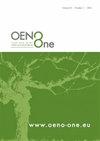Maximum stomatal conductance rather than stomatal sensitivity to drought differentiates the PIWI grapevine cultivar Souvignier gris from Muscaris and Donauriesling
IF 2.2
3区 农林科学
Q3 FOOD SCIENCE & TECHNOLOGY
引用次数: 0
Abstract
Pioneering grapevines also referred to as “PIWIs” (after the German expression “pilzwiderstandsfähig” = fungus resistant), represent an interesting alternative to classic cultivars in several wine regions. Their resistance to some fungal diseases places them among the potential solutions for sustainability, especially under organic production systems. However, little is known about their response to abiotic stressors, such as water stress under drought conditions. Here we studied the response of three PIWI cultivars (Donauriesling, Muscaris, Souvignier gris, and Riesling or Grüner Veltliner Vitis vinifera cultivars as comparison; all plants without fruit) to drought under semi-controlled conditions over two consecutive seasons. While in season 2020, we imposed a single dry-down and re-watering cycle inside a glasshouse, during season 2021, we subjected the vines to three cycles of dehydration and re-watering under field conditions with the aid of a rain shelter. Along the experiments, we monitored leaf gas exchange and water potential during soil dehydration and characterised leaf area development and some key leaf hydraulic traits. Despite different conditions in our two study seasons, we found connective significances in some key parameters. Under well-watered conditions, Souvignier gris had the highest rates of stomatal conductance, whereas Muscaris exhibited the most conservative water use behaviour. When under drought, Souvignier gris showed an apparent less tight stomatal control than the other PIWIs in coordination with a lower (more negative) osmotic potential and turgor loss point. Our results suggest that Muscaris (and Donauriesling showed similar behaviour) might be more suitable for non-irrigated conditions than Souvignier gris. However, further research on berry composition and open field is needed to upscale our results and address the water management of PIWI vineyards.最大气孔导度而不是气孔对干旱的敏感性将PIWI葡萄品种灰苏与毒蕈和多纳雷司令区分开来
先锋葡萄藤也被称为“PIWIs”(源于德语“pilzwiderstandsfähig”=抗真菌),在一些葡萄酒产区代表了经典品种的有趣替代品。它们对某些真菌疾病的抵抗力使它们成为可持续发展的潜在解决方案之一,特别是在有机生产系统下。然而,人们对它们对非生物胁迫的反应知之甚少,比如干旱条件下的水胁迫。本研究以多瑙里斯、Muscaris、Souvignier gris、Riesling或grnner Veltliner Vitis vinifera三个PIWI品种为对照,进行了响应研究;所有不结果的植物)在半受控条件下连续两个季节遭受干旱。在2020年的季节,我们在温室内进行了一次干燥和再浇水循环,在2021年的季节,我们在遮雨棚的帮助下,在野外条件下对葡萄藤进行了三个脱水和再浇水循环。在试验过程中,我们监测了土壤脱水过程中叶片气体交换和水势,并对叶片面积发育和一些关键的叶片水力性状进行了表征。尽管我们两个研究季节的情况不同,但我们在一些关键参数中发现了关联意义。在水分充足的条件下,灰葡萄的气孔导度最高,而白葡萄则表现出最保守的水分利用行为。干旱条件下,苏维尼叶的气孔控制明显不如其他PIWIs严密,渗透势和膨松损失点较低(负)。我们的研究结果表明Muscaris(和Donauriesling表现出类似的行为)可能比Souvignier gris更适合非灌溉条件。然而,需要进一步研究浆果成分和开放田,以完善我们的研究成果,并解决PIWI葡萄园的水分管理问题。
本文章由计算机程序翻译,如有差异,请以英文原文为准。
求助全文
约1分钟内获得全文
求助全文
来源期刊

OENO One
Agricultural and Biological Sciences-Food Science
CiteScore
4.40
自引率
13.80%
发文量
85
审稿时长
13 weeks
期刊介绍:
OENO One is a peer-reviewed journal that publishes original research, reviews, mini-reviews, short communications, perspectives and spotlights in the areas of viticulture, grapevine physiology, genomics and genetics, oenology, winemaking technology and processes, wine chemistry and quality, analytical chemistry, microbiology, sensory and consumer sciences, safety and health. OENO One belongs to the International Viticulture and Enology Society - IVES, an academic association dedicated to viticulture and enology.
 求助内容:
求助内容: 应助结果提醒方式:
应助结果提醒方式:


